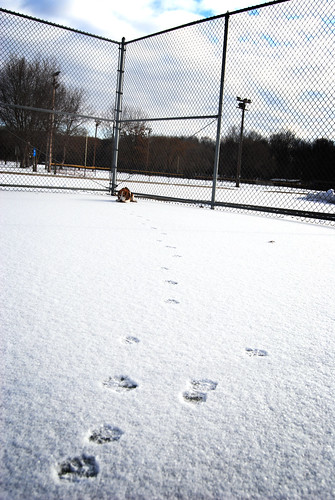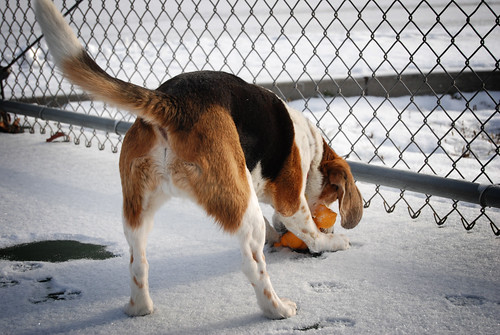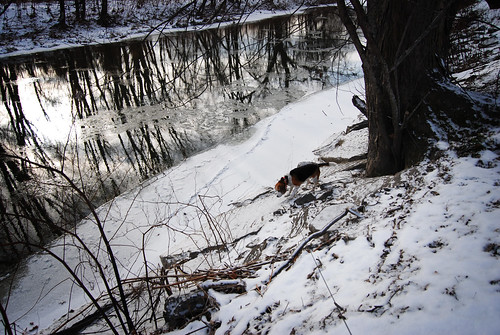these photos were taken in endicott, new york. while andre and petey were busy at the karen pryor workshops, duke and i explored the local parks.
Wednesday, December 30, 2009
Sunday, December 27, 2009
Behavior Adjustment Training (BAT) for Leash-Aggressive Dog
I was recently introduced to Behavior Adjustment Training (BAT) for treating fear/aggression (as well as its sister technique, CAT, or Constructional Aggression Treatment).
Having gotten Duke to a certain level using food and classical counter conditioning/desensitization, I am interested in new techniques that could be faster. Maybe BAT is faster than classical counter conditioning and desensitization. Who knows. I'm going to give it a try with Duke and see how he likes it.
More posts soon!
Having gotten Duke to a certain level using food and classical counter conditioning/desensitization, I am interested in new techniques that could be faster. Maybe BAT is faster than classical counter conditioning and desensitization. Who knows. I'm going to give it a try with Duke and see how he likes it.
More posts soon!
Labels:
aggression,
beagle,
behavior,
dog,
dog behavior,
dog behaviour,
duke
Saturday, December 5, 2009
petey spam
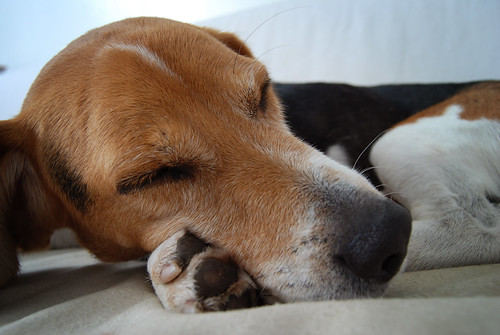
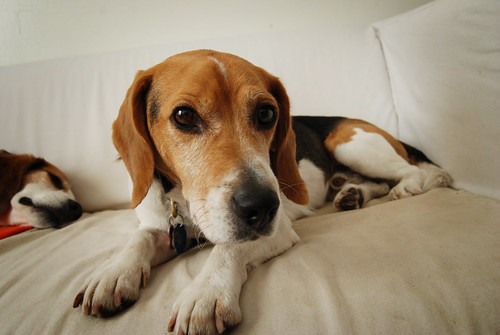
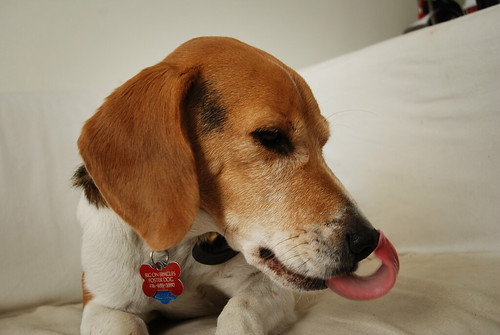

i'm happy to report that we haven't had any biting incidents in the last couple of months because we know exactly what petey's triggers are.
he is house trained now and starts sniffing and circling the room when he wants to do his business - a great cue for us.
he is also a very snuggly beagle and so affectionate.
i'm going to have a lot of trouble giving him up! and secretly i'm hoping that people will be scared off by his biting history and won't apply to adopt him.... but that would be just selfish of me. petey has so much love to give, i shouldn't keep it all to myself :)
Thursday, November 26, 2009
Petey learning to target with his paw
Right now I am working on having Petey learn to target with both his nose and his paw.
Here's video of my first session teaching Petey how to touch a post it note with his paw. He is getting very clicker saavy and new behaviors are only taking one or two sessions, a couple of minutes each to teach now.
Here's video of my first session teaching Petey how to touch a post it note with his paw. He is getting very clicker saavy and new behaviors are only taking one or two sessions, a couple of minutes each to teach now.
Friday, November 20, 2009
"Alpha" and "Pack Leader" theory discarded by the man who invented the term "Alpha"
Thanks to TV (Cesar Millan of Dog Whisperer and Brad Pattison of End of My Leash fame) a lot of average people throw out the term "alpha" and "pack leader" and automatically assume a misbehaving dog is doing so because it thinks its dominant and the leader.
Both Cesar and Brad likely read Dr. L .David Mech's 1970 study about wolf packs where the term Alpha was first used.
Dr. Mech has gone on record numerous times to say his study was flawed and as he puts it - a lot of learning has happened since 1970 and the theories he put forth in 1970 don't actually hold true.
Of course, National Geographic and Slice would rather you not know that, since it discredits the misinformation that their two popular shows continue to propogate. For ratings its sometimes more convenient to continue telling people that the sun does revolve around the earth.
Bottom line is - dogs are not wolves. We don't learn to parent by watching chimps. And even if you want to believe a dog is like a wolf, wolves in the wild don't have alphas and don't fight for pack leadership and don't flip or pin their family down. Flipping and pinning, even if you're calm and assertive, has no place in dog obedience and training.
Both Cesar and Brad likely read Dr. L .David Mech's 1970 study about wolf packs where the term Alpha was first used.
Dr. Mech has gone on record numerous times to say his study was flawed and as he puts it - a lot of learning has happened since 1970 and the theories he put forth in 1970 don't actually hold true.
Of course, National Geographic and Slice would rather you not know that, since it discredits the misinformation that their two popular shows continue to propogate. For ratings its sometimes more convenient to continue telling people that the sun does revolve around the earth.
Bottom line is - dogs are not wolves. We don't learn to parent by watching chimps. And even if you want to believe a dog is like a wolf, wolves in the wild don't have alphas and don't fight for pack leadership and don't flip or pin their family down. Flipping and pinning, even if you're calm and assertive, has no place in dog obedience and training.
Thursday, November 5, 2009
Karen Pryor Academy Workshop 1 with Steve Benjamin and Casey Lomonaco
Last weekend, Hyedie, Duke, Petey, and I drove down to Endicott, New York for Workshop 1 in the Karen Pryor Academy. What a great experience! The class is small (5 students in total) and it was basically 16 hours of non stop learning. The work we did leading up to the workshop put me on a great learning path of self discovery, and the workshop helped drive things home for me and answer questions there were lingering.
Petey performed "Yummo-o" (tongue lick on cue), "Go to Bed", "Get in a Box" and a new trick "Hup" (Jump over my bended knee) like a champ for the class!
Here's a video of my work on Get in a Box. I finished shaping the behavior with Petey actually downing in the box, so that all you can see is the tip of his tail sticking out (in the video I hadn't finished shaping that last step)
Lastly, Petey received some free training during breaks from Casey Lomonaco, a KPA certified training partner and also an avid blogger/writer on web sites I've noted such as Dog Star Daily or Clickertraining.com, and is also the winner of the 2009 Dogwise APDT John Fisher essay award. Her blog articles are extremely well written and introduce new ideas. Here's an example:
Shoddy Clicker Training and the Importance of Premack
(Worth another blog post on it's own, but she introduces the premack principal here - something I've done instinctively, thinking it was a way to celebrate and honor Duke's hunting history by allowing him to drag me through bushes to try to find rabbits).
Petey performed "Yummo-o" (tongue lick on cue), "Go to Bed", "Get in a Box" and a new trick "Hup" (Jump over my bended knee) like a champ for the class!
Here's a video of my work on Get in a Box. I finished shaping the behavior with Petey actually downing in the box, so that all you can see is the tip of his tail sticking out (in the video I hadn't finished shaping that last step)
Lastly, Petey received some free training during breaks from Casey Lomonaco, a KPA certified training partner and also an avid blogger/writer on web sites I've noted such as Dog Star Daily or Clickertraining.com, and is also the winner of the 2009 Dogwise APDT John Fisher essay award. Her blog articles are extremely well written and introduce new ideas. Here's an example:
Shoddy Clicker Training and the Importance of Premack
(Worth another blog post on it's own, but she introduces the premack principal here - something I've done instinctively, thinking it was a way to celebrate and honor Duke's hunting history by allowing him to drag me through bushes to try to find rabbits).
Wednesday, October 21, 2009
Lure-Reward vs Shaping
I've been busy lately! In September I was accepted to the Karen Pryor Academy and I have been working very diligently on the program... I was going to work with Duke through the program, but I've decided to work with Petey instead, so that when we're finished, he'll have skills that will give him the biggest leg up he'll have in life.
Karen Pryor wrote the seminal "Don't Shoot the Dog!" back in the mid 80s and is basically the trainer who brought clicker training from the dolphin world to the dog world.
Prior to beginning the program I was strictly a lure-reward style positive reinforcement trainer. Karen Pryor's curriculum is all about Free Shaping or Capturing, which I've learned is very different than lure-reward, even though the tools are the same (reinforcers, event marker aka clicker, positive reinforcement etc.)
I'll blog more about my experience with Shaping and Capturing vs Lure-Reward, but for now... two videos of Petey!
Petey at class at Who's Walking Who - restrained recalls, musical mats, and leave it (food on the floor) game.
Free Shaping "Go to Bed"
Karen Pryor wrote the seminal "Don't Shoot the Dog!" back in the mid 80s and is basically the trainer who brought clicker training from the dolphin world to the dog world.
Prior to beginning the program I was strictly a lure-reward style positive reinforcement trainer. Karen Pryor's curriculum is all about Free Shaping or Capturing, which I've learned is very different than lure-reward, even though the tools are the same (reinforcers, event marker aka clicker, positive reinforcement etc.)
I'll blog more about my experience with Shaping and Capturing vs Lure-Reward, but for now... two videos of Petey!
Petey at class at Who's Walking Who - restrained recalls, musical mats, and leave it (food on the floor) game.
Free Shaping "Go to Bed"
Monday, August 17, 2009
Dr. Ian Dunbar and Dog Star Daily - Phasing out Food Rewards

Just another great site and Ph.D dog behaviorist extraodinaire to share with the readers: Dr. Ian Dunbar and his web site www.dogstardaily.com
http://www.dogstardaily.com/training/quantum-leaps
Chock full of great information - here is an article that talks about phasing out food rewards.
Excerpt: Quantum Leaps
You will make four quantum leaps in training as you phase out hand-held training lures, and eventually all training rewards. Phasing out food lures is a simple matter — just put them in your pocket to be used as rewards for above-average responses. Phasing out food rewards is similarly simple — just empty your pockets of food and use something else as a reward.
Friday, August 7, 2009
Some more Dr. Yin at AskDrYin.com
This video of Dr. Yin working with Podee, a fear aggressive dog is outstanding!!!!
Tuesday, July 21, 2009
Desensitizing your Dog to Paw and Tail Grabbing
I'm feeding Petey in the above video by hand. My goal is to accomplish the following:
1) Condition Petey to think of me more positively.
2) Condition Petey to think of my hands very positively (kibble's coming out of my hands)
3) Condition Petey to get used to his paws, legs, tail, and bum being touched and to make him feel better about it (as he gets to eat while I do it)
(Duke's in the background behind the babygate watching)
Sunday, July 19, 2009
Housetraining and Crate Training - Petey the Foster Beagle
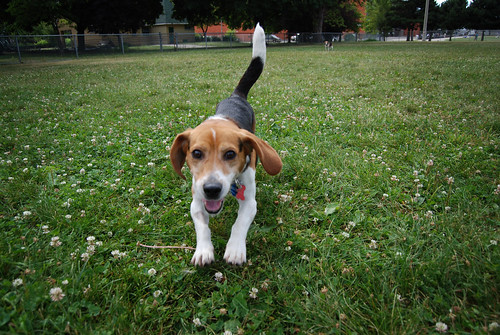
Its been about 6 months since we helped Elmo find his forever home (he's doing well and his new family love him!). We kept a spot open for another foster dog but it had to be the right one. One that was a bit more challenging. Well we found him.
Meet Petey, a lovely 5 year old (estimated) beagle found in the woods in rural Ontario.
The shelter was expecting a quick adoption for him since he's a sweety, but unfortunately, when he gets handled roughly (too quick or too strong touches to his hind area) he warning bites. A vet was bit when he was getting poked and prodded, and as a result, the shelter could not adopt him out. If he didn't find a foster home he would have been PTS (put to sleep).
We took him into Foster via Big On Beagles (www.bigonbeagles.ca) and he'll likely be with us for a few months until we've had a chance to work on his behavioral issues. He has no training (he doesn't even know how to sit pretty to beg for food) but in the three days we've had him I can tell you he has tremendous potential - he is a VERY fast learner.
As he's a wild one we're doing all the basics. There are some basic rules of crating I'll share first:
1. Crates are never used as punishment.
2. Use food or toys to get them to go in - don't ever push their behind him. Good examples would be a Kong stuffed with treats and cheese/peanut butter, or his dinner in a bowl. If you are in a pinch and can't wait, you can pick the dog up off his legs and "toss" him in - but this way you aren't turning it into a wrestling match.
3. The dog will likely fuss and fight and bark and howl to get out once he realizes that he's "stuck". In an ideal world, you would slowly build up the amount of time from seconds to minutes so that your dog doesn't get to that point while learning how to be in the crate, but since we're potty training an adult dog, we have no choice but to leave him in there while his bladder fills and he learns to hold it.
4. So you just have to let the dog howl and cry it out. The behavior will extinguish itself when the dog realizes all the fussing in world doesn't get them out. Alternatively, if the dog howls and barks and you cave and let them out, you've basically rewarded that behavior and really set yourself back.
5. During this "cry it out" phase, it would be a good idea to place him in a quiet area without traffic. You could use the basement or garage or a small guest room and close the windows/drapes/etc. to try to make this part bearable. If you left him in the living room while doing this, the comings and goings of family members could be regarded as a reward for his fussing. So he really needs to be isolated for a while to figure this out.
6. When he's ready to be let out, make sure he's totally quiet and relaxed. That way he'll notice that the only time he ever gets let out is in that state of relaxation.
7. If you're potty training, keep the leash near the crate so that when you let him out, you can leash him up and run, don't walk to the yard. The minute he relieves himself, act like you won the lottery and give him a piece of sandwich meat or a liver or other high value treat.
Our first priority is to housetrain and crate train him and this is what we've been doing:
Day 1 (night of arrival) - Brought crate to our bedroom and threw treats in to entice Petey in. He went in and we closed the door. He howled and whined from midnight to 2am and finally we were able to sleep. Friday was a tough day at work.
Day 2 - He was crated all day for 2-3 hour shifts and only let out to pee in the yard (met with lavish praise and treats for appropriate eliminating) and also allowed in the kitchen under close supervision. He marked the sofa once and my messenger bag once by accident but since then no mistakes. When being returned to the crate, we entice with chicken or treats or his food bowl and meal, but he's hesitant to go in. We show him the food and slowly guide his nose into the crate.
Day 3 - More of the same - instead of howling for 2 hours after going in, he's progressively gotten better... first 30 minutes, then he settles, then 20, then 10 - after 10+ repetitions of this crating, he now only howls for 1-2 minutes before settling. This is encouraging since it likely means he will be a quiet crated dog, meaning he could likely be a match for a condos and apartments too.
For now when we crate during the day, we isolate him socially (upstairs) while we work downstairs, but overnight we let him crate in our bedroom. We let him roam under supervision and since the first two accidents, he's not marked, so hopefully we'll have him reliably potty trained very quickly so that we can stop using the crate for potty training (and start playing fun crating games so that he doesn't have a long-term negative association with crating).
Tuesday, July 14, 2009
On Using Food and Treats...
(Firstly... I'm pleased to announce I have launched my dog training services in Toronto under the banner of When Hounds Fly! - www.whenhoundsfly.com - Many of my posts will also appear over there in the Articles section.)
I use food and treats liberally when training dogs. 95% of dogs out there are food motivated. When I meet owners who say their dog isn't that into their food, it's normally because their kibble is, well, bland and tasteless. Put some cheese or diced sandwich meat in front of them and their food motivation surfaces.
If you talk to someone who says that using food in training is a bad idea, run, don't walk, away.
These people might also tell you that its bribery, and that dogs don't teach pups how to behave with food, and that using food can make a dog food aggressive - ask them where the science behind those statements are. They don't have an ounce of academia to back them up. Brad Pattison of "The End of My Leash" fame on Slice is the worst offender (and although I love the cute dogs on the show - he's the least qualified and worst dog trainer I can imagine - his self-taught techniques embody NONE of the benefits of positive reinforcement training and FEW of the benefits of traditional punishment training).
I'm often asked by new clients, especially ones that have been brainwashed by shows like The End of My Leash or people that have never worked with a knowledgeable positive reinforcement trainer the following questions:
"If I use food, doesn't that mean I'll have to use and have food all the time, or else Spot won't behave?"
"Will he respect me if I'm just a pez dispenser?"
"Won't he get fat?"
Here's a few points that explain how food SHOULD be used for training.
There are at least three functions of food. Firstly, it can be used as a LURE. An example of this is if you are trying to teach your dog to climb a ramp, keeping a piece of cheese in between your index finger and thumb, and guiding the dog's nose up the ramp can get him there. Secondly, it is used as a REWARD. Once the dog has reached the top of the ramp, he's accomplished the desired behavior. You can give him the cheese. Thirdly, it can be used as a bribe in the case of an emergency. A classic example I've seen at the dog park is when a dog who hasn't learned a recall is collected. The owner reaches into a pocket and pulls out a treat and calls their dogs' name fifty times and waves the juicy treat in the air, hoping and praying that their dog will come back.
Lures are used early on in teaching a new behavior, but only initially. This is when the dog really doesn't know the behavior and its not natural. Rewards are used liberally at first, but over time, phased out, and eventually eliminated. For example, you might give a 5 year old a reward for spelling their name right or answering 2+2, but that behavior is expected once they're 7. Lastly, a bribe as I've described is probably the biggest reason why food training has a bad rep. This is simply a case of a useful tool being totally misused by an unqualified handler - like a tennis racket being used to pound nails.
Regarding respect - a dog ultimately respects the person or thing that has control of the resources. Resources in a dog's world include food, water, shelter, access to play, access to rest, toys, and affection (and probably more). Using food in the ways I've described is a respect-neutral behavior. Conversely, using punishment (hitting your dog, yelling at your dog, choking your dog) is a respect-neutral behavior too. However, how do you think your dog's confidence and your dog's bond with you is affected?
Lastly, you're in control of your dog's caloric intake. Every calorie of food should be worked for - a bowl full of food given for nothing is a waste of a training opportunity. If you are hell bent on building a relationship based on respect, then demanding a behavior for every morsel of food is something you should build into every day. For example, when working on the behavior of not rushing the door when the doorbell rings, why not use meal time as an opportunity to practice running into the crate when the doorbell rings? A bowl full of food can be used both as a lure (after you or someone else ring the doorbell, you take the bowl of food and throw it into the crate) and a reward (after going in the crate, your dog is rewarded by a satisfying meal). It won't take long for your dog to learn that the doorbell means its time to go into the crate. You've made your dog work for it, helped shape a desirable behavior, and stimulated your dog both mentally and physically.
I use food and treats liberally when training dogs. 95% of dogs out there are food motivated. When I meet owners who say their dog isn't that into their food, it's normally because their kibble is, well, bland and tasteless. Put some cheese or diced sandwich meat in front of them and their food motivation surfaces.
If you talk to someone who says that using food in training is a bad idea, run, don't walk, away.
These people might also tell you that its bribery, and that dogs don't teach pups how to behave with food, and that using food can make a dog food aggressive - ask them where the science behind those statements are. They don't have an ounce of academia to back them up. Brad Pattison of "The End of My Leash" fame on Slice is the worst offender (and although I love the cute dogs on the show - he's the least qualified and worst dog trainer I can imagine - his self-taught techniques embody NONE of the benefits of positive reinforcement training and FEW of the benefits of traditional punishment training).
I'm often asked by new clients, especially ones that have been brainwashed by shows like The End of My Leash or people that have never worked with a knowledgeable positive reinforcement trainer the following questions:
"If I use food, doesn't that mean I'll have to use and have food all the time, or else Spot won't behave?"
"Will he respect me if I'm just a pez dispenser?"
"Won't he get fat?"
Here's a few points that explain how food SHOULD be used for training.
There are at least three functions of food. Firstly, it can be used as a LURE. An example of this is if you are trying to teach your dog to climb a ramp, keeping a piece of cheese in between your index finger and thumb, and guiding the dog's nose up the ramp can get him there. Secondly, it is used as a REWARD. Once the dog has reached the top of the ramp, he's accomplished the desired behavior. You can give him the cheese. Thirdly, it can be used as a bribe in the case of an emergency. A classic example I've seen at the dog park is when a dog who hasn't learned a recall is collected. The owner reaches into a pocket and pulls out a treat and calls their dogs' name fifty times and waves the juicy treat in the air, hoping and praying that their dog will come back.
Lures are used early on in teaching a new behavior, but only initially. This is when the dog really doesn't know the behavior and its not natural. Rewards are used liberally at first, but over time, phased out, and eventually eliminated. For example, you might give a 5 year old a reward for spelling their name right or answering 2+2, but that behavior is expected once they're 7. Lastly, a bribe as I've described is probably the biggest reason why food training has a bad rep. This is simply a case of a useful tool being totally misused by an unqualified handler - like a tennis racket being used to pound nails.
Regarding respect - a dog ultimately respects the person or thing that has control of the resources. Resources in a dog's world include food, water, shelter, access to play, access to rest, toys, and affection (and probably more). Using food in the ways I've described is a respect-neutral behavior. Conversely, using punishment (hitting your dog, yelling at your dog, choking your dog) is a respect-neutral behavior too. However, how do you think your dog's confidence and your dog's bond with you is affected?
Lastly, you're in control of your dog's caloric intake. Every calorie of food should be worked for - a bowl full of food given for nothing is a waste of a training opportunity. If you are hell bent on building a relationship based on respect, then demanding a behavior for every morsel of food is something you should build into every day. For example, when working on the behavior of not rushing the door when the doorbell rings, why not use meal time as an opportunity to practice running into the crate when the doorbell rings? A bowl full of food can be used both as a lure (after you or someone else ring the doorbell, you take the bowl of food and throw it into the crate) and a reward (after going in the crate, your dog is rewarded by a satisfying meal). It won't take long for your dog to learn that the doorbell means its time to go into the crate. You've made your dog work for it, helped shape a desirable behavior, and stimulated your dog both mentally and physically.
Sunday, July 5, 2009
Dear New Dog Owner...
Dear New Dog Owner...
(If time travel existed, this is the letter I'd send to myself when I first became a new dog owner.)
Congratulations! Right now you are fascinated, anxious, and excited that there is a living, breathing dog in your condo. There's a whole world of fun ahead of you and tons of emotional growth you'll experience over time. You have no idea how good it'll be and how your life will change.
I have to warn you though - there are many things about dogs that aren't common sense and you really should know now on day one.
1. Dog socializing is not forcing your dog to meet every dog on the sidewalk, every dog at the park, or any dog tied up outside the supermarket. You wouldn't allow a 10 year old child to "go play" with all the kids standing around the corner store, so why would you do that to your dog? Socializing your dog is about making him feel comfortable just being in the company of other dogs, which may or may not mean a meet and greet. In fact, two dogs meeting on leash on a narrow sidewalk is a very tense situation - kind of like when the mafia and the yakuza meet in a warehouse for a drug deal. There's a good chance somebody will get nervous and accidentally pull the trigger, setting off a big kerfuffle.
2. The books about dog behavior stocked at your local bookstore are generally garbage - save your money. Start by reading Patricia McConnell's "The Other End of the Leash". If you pick up a book that talks about Wolf packs or Dominance, put it down.
3. Ditto with the programs on TV. I admit, I do watch Dog Whisperer and End of my Leash, but mainly because I think the dogs are cute. The training is abusive - you won't be able to tell at this point, but the dogs being "trained" there are under intense psychological stress and trauma. If you are lucky enough to get Animal Planet, do watch Victoria Stillwell's "It's Me or the Dog" though.
4. Don't be in such a rush to let your new dog off leash. Off leash is a privilege for both YOU and your dog - one that must be earned with work.
5. You'd think a dog park is exactly where your dog would want to play. You'd be surprised though, I think he'd rather be playing with YOU somewhere quiet. But you need to learn how to play with your dog and be interesting to him. Start with Tug of War and Fetch.
6. This may be a lot to ask early on, but kibble is terrible for him. For now, can you just add some table scraps on top of his food bowl each night? Just no onions or grapes.
7. Get pet insurance. You will spend more each year than the premium.
8. Work with a private dog trainer that uses positive reinforcement NOW - don't wait. An ounce of prevention is a pound of cure.
Sincerely,
Me in the Future

PS. You know when he's doing that - he's rolling around in poop or rotten food.
(If time travel existed, this is the letter I'd send to myself when I first became a new dog owner.)
Congratulations! Right now you are fascinated, anxious, and excited that there is a living, breathing dog in your condo. There's a whole world of fun ahead of you and tons of emotional growth you'll experience over time. You have no idea how good it'll be and how your life will change.
I have to warn you though - there are many things about dogs that aren't common sense and you really should know now on day one.
1. Dog socializing is not forcing your dog to meet every dog on the sidewalk, every dog at the park, or any dog tied up outside the supermarket. You wouldn't allow a 10 year old child to "go play" with all the kids standing around the corner store, so why would you do that to your dog? Socializing your dog is about making him feel comfortable just being in the company of other dogs, which may or may not mean a meet and greet. In fact, two dogs meeting on leash on a narrow sidewalk is a very tense situation - kind of like when the mafia and the yakuza meet in a warehouse for a drug deal. There's a good chance somebody will get nervous and accidentally pull the trigger, setting off a big kerfuffle.
2. The books about dog behavior stocked at your local bookstore are generally garbage - save your money. Start by reading Patricia McConnell's "The Other End of the Leash". If you pick up a book that talks about Wolf packs or Dominance, put it down.
3. Ditto with the programs on TV. I admit, I do watch Dog Whisperer and End of my Leash, but mainly because I think the dogs are cute. The training is abusive - you won't be able to tell at this point, but the dogs being "trained" there are under intense psychological stress and trauma. If you are lucky enough to get Animal Planet, do watch Victoria Stillwell's "It's Me or the Dog" though.
4. Don't be in such a rush to let your new dog off leash. Off leash is a privilege for both YOU and your dog - one that must be earned with work.
5. You'd think a dog park is exactly where your dog would want to play. You'd be surprised though, I think he'd rather be playing with YOU somewhere quiet. But you need to learn how to play with your dog and be interesting to him. Start with Tug of War and Fetch.
6. This may be a lot to ask early on, but kibble is terrible for him. For now, can you just add some table scraps on top of his food bowl each night? Just no onions or grapes.
7. Get pet insurance. You will spend more each year than the premium.
8. Work with a private dog trainer that uses positive reinforcement NOW - don't wait. An ounce of prevention is a pound of cure.
Sincerely,
Me in the Future

PS. You know when he's doing that - he's rolling around in poop or rotten food.
Monday, June 1, 2009
Counter Conditioning - TIMING IS EVERYTHING!
In the last two months we've been working on changing Duke's underlying attitude towards dogs. Much of the work we started off earlier was about teaching incompatible behaviors (i.e. Duke sees dog, he looks at us) but now we're tackling things a bit more head on.
For example, at the dog park - when we unleash Duke and dogs come to greet him, we click and treat as the dog approaches and Duke stays calm. (he takes the treat). When a dog approaches and sniffs Duke appropriately, we click and treat. When Duke approaches a dog and sniffs nicely, we click and treat. The result after just a couple of weeks has been phenomenal. While in the past, Duke used to let out a warning howl and snap to send incoming dogs away, now he tolerates their arrival and allows them to sniff him (and he will often sniff them back).
At the dog park, we usually do this work off-leash. I've gotten good at throwing a treat such that Duke sees it coming and can eat it in mid-air (or anticipate where it'll fall and pick it off the ground right away).
We've been doing the same, on-leash, with certain dogs on the street and sidewalk. Click and treat just for the mere presence of another dog (we're not asking for him to sit or look at us). Click and treat as the dog approaches. Click and treat after Duke passes the other dog. Click and treat if we can get them to meet on leash (major jackpot here).
A couple of things to keep in mind:
1. Safety - we've gone back to using the Gentle Leader so that we can close up Duke's mouth if ever he decided to bite another dog. Also a side effect of the Gentle Leader is it adds a certain level of suppression to Duke, which makes it a bit easier. (Suppression, as I see it, is the underlying fear of something unpleasant - in this case, pulling up to close the Gentle Leader is not exactly a fun thing)
2. Level of intensity and Flooding - if Duke won't take the food (I have waved milk bones right in front of his nose and he's turned away from them) it means the stimulus is too great. If this happens, you either have to lower the intensity (distance is best, or sometimes the particular dog is too "hot" for him) or increase the intensity of the reward.
3. TIMING IS EVERYTHING. The moment you click and treat is really critical. It has to be done the split second your dog's brain picks up the stimulus as its fed from his eyes. Its that split second where his brain is processing what the stimulus means where you have the opportunity to input meaning by a well timed click and treat. If you haven't had a professional dog trainer or behaviorist tell you that your training is bang-on, don't attempt this sort of program without getting expert help. If you're in the Toronto area, I can help you, or I can recommend someone who can.
I recently watched this video by Dr. Sophia Yin that really illustrates the power of classical counter conditioning. This video really shows that TIMING IS EVERYTHING.
For example, at the dog park - when we unleash Duke and dogs come to greet him, we click and treat as the dog approaches and Duke stays calm. (he takes the treat). When a dog approaches and sniffs Duke appropriately, we click and treat. When Duke approaches a dog and sniffs nicely, we click and treat. The result after just a couple of weeks has been phenomenal. While in the past, Duke used to let out a warning howl and snap to send incoming dogs away, now he tolerates their arrival and allows them to sniff him (and he will often sniff them back).
At the dog park, we usually do this work off-leash. I've gotten good at throwing a treat such that Duke sees it coming and can eat it in mid-air (or anticipate where it'll fall and pick it off the ground right away).
We've been doing the same, on-leash, with certain dogs on the street and sidewalk. Click and treat just for the mere presence of another dog (we're not asking for him to sit or look at us). Click and treat as the dog approaches. Click and treat after Duke passes the other dog. Click and treat if we can get them to meet on leash (major jackpot here).
A couple of things to keep in mind:
1. Safety - we've gone back to using the Gentle Leader so that we can close up Duke's mouth if ever he decided to bite another dog. Also a side effect of the Gentle Leader is it adds a certain level of suppression to Duke, which makes it a bit easier. (Suppression, as I see it, is the underlying fear of something unpleasant - in this case, pulling up to close the Gentle Leader is not exactly a fun thing)
2. Level of intensity and Flooding - if Duke won't take the food (I have waved milk bones right in front of his nose and he's turned away from them) it means the stimulus is too great. If this happens, you either have to lower the intensity (distance is best, or sometimes the particular dog is too "hot" for him) or increase the intensity of the reward.
3. TIMING IS EVERYTHING. The moment you click and treat is really critical. It has to be done the split second your dog's brain picks up the stimulus as its fed from his eyes. Its that split second where his brain is processing what the stimulus means where you have the opportunity to input meaning by a well timed click and treat. If you haven't had a professional dog trainer or behaviorist tell you that your training is bang-on, don't attempt this sort of program without getting expert help. If you're in the Toronto area, I can help you, or I can recommend someone who can.
I recently watched this video by Dr. Sophia Yin that really illustrates the power of classical counter conditioning. This video really shows that TIMING IS EVERYTHING.
Tuesday, March 31, 2009
Seminar on On-Leash Aggression - May 10 or 29
For those of you in the Greater Toronto Area - our behaviorist, Joan Weston, is having a two hour seminar on On-leash aggression via our school, Who's Walking Who - see below:
DESCRIPTION:
Does your dog lunge out at some dogs while on leash? Do you feel that you
don't have full control or your dog looses focus quickly? Is your dog
aggressive or just afraid? This seminar is will help sort out the reason
behind the reaction, and help to establish a plan of action to manage your
dogs actions. Joan Weston specializes in aggression and the rehabilitation
of dogs with issues. She is the staff Behaviorist for Who's Walking Who and
is a leading authority on this topic. She is the author of the popular "On
The Couch" column for Dogs Dogs Dogs newspaper and has studied ethology, the
science of behavior, with Dr. Raymond Coppinger. Her complete bio is on our
website, on our Behavioral Consultation page. For registration, if you have
more than one person to attend, please register each person individually.
Thanks.
SEMINAR LENGTH: 2 hours
SEMINAR FEE: $35.00
The two seminar dates are:
May 10, 2009 Sunday at 1:00 - 3:00 pm 889 Westney Road, Ajax 2 min south of
Hwy 401
May 29, 2009 Friday at 6:30 - 8:30 pm 97 Main Street (at Swanwick) Community
Centre 55 in Beaches
You can register here
http://www.whoswalkingwho.net/SeminarsEvents.aspx
If you register please put Helping Homeless Pets in the box that says "How
did you hear of our classes?"
DESCRIPTION:
Does your dog lunge out at some dogs while on leash? Do you feel that you
don't have full control or your dog looses focus quickly? Is your dog
aggressive or just afraid? This seminar is will help sort out the reason
behind the reaction, and help to establish a plan of action to manage your
dogs actions. Joan Weston specializes in aggression and the rehabilitation
of dogs with issues. She is the staff Behaviorist for Who's Walking Who and
is a leading authority on this topic. She is the author of the popular "On
The Couch" column for Dogs Dogs Dogs newspaper and has studied ethology, the
science of behavior, with Dr. Raymond Coppinger. Her complete bio is on our
website, on our Behavioral Consultation page. For registration, if you have
more than one person to attend, please register each person individually.
Thanks.
SEMINAR LENGTH: 2 hours
SEMINAR FEE: $35.00
The two seminar dates are:
May 10, 2009 Sunday at 1:00 - 3:00 pm 889 Westney Road, Ajax 2 min south of
Hwy 401
May 29, 2009 Friday at 6:30 - 8:30 pm 97 Main Street (at Swanwick) Community
Centre 55 in Beaches
You can register here
http://www.whoswalkingwho.net/SeminarsEvents.aspx
If you register please put Helping Homeless Pets in the box that says "How
did you hear of our classes?"
Friday, March 27, 2009
Never too early to start...
Xsara's mom has a new 12 week old puppy - and it is astonishing what she's been able to learn at such a young age! It is never too early to start!
Tuesday, March 3, 2009
play date with photon
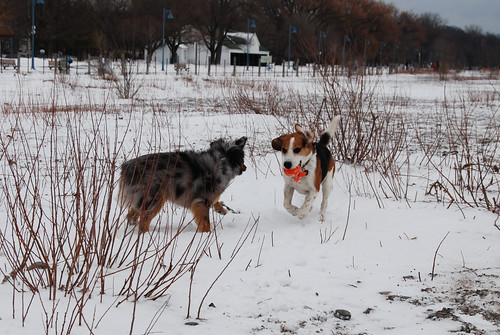
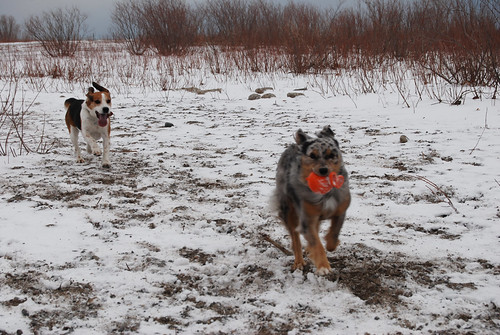
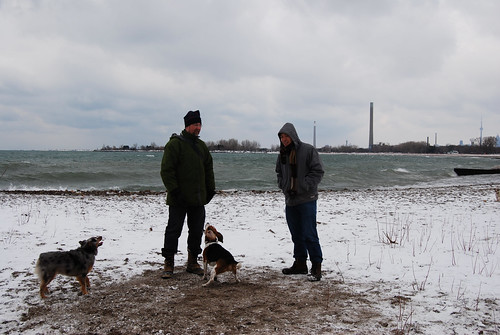
duke had a reunion with his classmate photon at the beaches off-leash dog park and had a howler-ific time. duke and photon hadn't seen each other since their 'step ahead' class almost 1.5 years ago.
photon impressed us with her leg weaving and duke blew out everybody's eardrums.
we also ran into a classmate from duke's current obedience class!
thanks peter for putting up with duke's overly enthusiastic howling and meeting us in the freezing cold!
i'm sure duke had a really great time playing fetch with photon!
Wednesday, February 18, 2009
Lessons from Practical Living, Class Four
(Woops, I missed a post about Class Three)
Today, Duke was a champ! No incidents of howling in class and he was focused the whole time. A few factors playing into his outstanding performance:
1) He's had bouts of diarrhea in the last few weeks due to a diet switch and eating a lot of melting food from the streets. He's feeling better. Illness or injury plays a huge part in reactivity.
2) We fast him on school nights so he's more motivated to do work. Basically he gets a very small breakfast and that's it all day. This just increases his motivation and drive for food reward.
3) We also put cheddar cheese into the treat bag (thereby increasing the value of the rewards)
We were able to walk by many dogs in class, and have many dogs walk by us, and Duke either held it together or we were able to put him in a backaway.
In today's class we learned:
1) Down stay while reading the newspaper
2) Down stay while getting up to go to the door and come back
3) Down stay while other dogs are recalled (Last year, Duke couldn't do this in Step Ahead - he'd recall to the arms of other dog owners calling COME - this year he nailed it!)
4) Go to your Bed
5) Emergency stay mid-recall (see video)
Well done Dukey!
Today, Duke was a champ! No incidents of howling in class and he was focused the whole time. A few factors playing into his outstanding performance:
1) He's had bouts of diarrhea in the last few weeks due to a diet switch and eating a lot of melting food from the streets. He's feeling better. Illness or injury plays a huge part in reactivity.
2) We fast him on school nights so he's more motivated to do work. Basically he gets a very small breakfast and that's it all day. This just increases his motivation and drive for food reward.
3) We also put cheddar cheese into the treat bag (thereby increasing the value of the rewards)
We were able to walk by many dogs in class, and have many dogs walk by us, and Duke either held it together or we were able to put him in a backaway.
In today's class we learned:
1) Down stay while reading the newspaper
2) Down stay while getting up to go to the door and come back
3) Down stay while other dogs are recalled (Last year, Duke couldn't do this in Step Ahead - he'd recall to the arms of other dog owners calling COME - this year he nailed it!)
4) Go to your Bed
5) Emergency stay mid-recall (see video)
Well done Dukey!
Labels:
beagle,
dog behavior,
dog behaviour,
dog obedience,
dog training,
duke
Wednesday, February 4, 2009
Lessons from Practical Living, Class Two
Tonight was not so good a class for Duke's on leash aggression.
We got there about 20 minutes early and because the class is so full (12 dogs?) the lobby area was rammed and we were too nervous to go in. As we paced outside in the cold for 15 minutes, Duke was very sensitive and howled at pretty much every dog that was going in or coming out or going by. By the time we got into class, Duke's brain was tired out so he was only able to give us about 20 minutes of good work.
The big lesson we learned here is it is probably better to arrive just before class is about to get started. The lobby will be empty, and we won't waste Duke's energy outside the building or trying to get into the building without incident. Dogs only can focus for so long before they get tired and lose interest so its best to quit ahead. In fact, with 10 minutes left in the class, when a freezed dried liver delicacy put in front of his nose did nothing for him.
Some pluses - For every one time Duke howled at one of the dogs in class there were dozens of times he chose not to, and we were able to leave the facility and have Duke walk by two dogs at close proximity without any fuss.
We'll get it right next week!
Agenda from this week's class:
- Loose leash walking review
- Sit with your dog in down position, while other dogs circle your dog
- "Leave it" with food on the counter
- Back up - have your dog walk backwards
- "May I pet your dog?" - stranger pets your dog without him jumping up or acting silly
- "Hello how do you do?" - stranger approaches you but does not want to touch the dog
- Meet a dog on leash and recall from dog
We got there about 20 minutes early and because the class is so full (12 dogs?) the lobby area was rammed and we were too nervous to go in. As we paced outside in the cold for 15 minutes, Duke was very sensitive and howled at pretty much every dog that was going in or coming out or going by. By the time we got into class, Duke's brain was tired out so he was only able to give us about 20 minutes of good work.
The big lesson we learned here is it is probably better to arrive just before class is about to get started. The lobby will be empty, and we won't waste Duke's energy outside the building or trying to get into the building without incident. Dogs only can focus for so long before they get tired and lose interest so its best to quit ahead. In fact, with 10 minutes left in the class, when a freezed dried liver delicacy put in front of his nose did nothing for him.
Some pluses - For every one time Duke howled at one of the dogs in class there were dozens of times he chose not to, and we were able to leave the facility and have Duke walk by two dogs at close proximity without any fuss.
We'll get it right next week!
Agenda from this week's class:
- Loose leash walking review
- Sit with your dog in down position, while other dogs circle your dog
- "Leave it" with food on the counter
- Back up - have your dog walk backwards
- "May I pet your dog?" - stranger pets your dog without him jumping up or acting silly
- "Hello how do you do?" - stranger approaches you but does not want to touch the dog
- Meet a dog on leash and recall from dog
Wednesday, January 28, 2009
Lessons from Practical Living, Class One
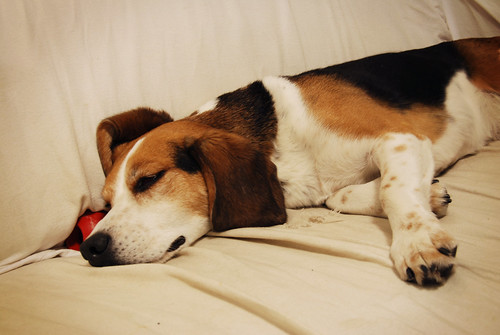
After a year hiatus, Duke's back at school! Today was his first day for the Practical Living class at Who's Walking Who, Toronto campus.
The actual class content is a good refresher for Duke, and will be good finishing work, but the main reason why we're there is to expose Duke to as many dogs as possible in a difficult environment to help with his on-leash aggression.
This class is extremely challenging for that aspect, because it is a full house (10+ dogs) in the class prior, and a full house itself (10+ dogs in our class) meaning that Duke has to manage himself in a small room where 20 dogs will go by him at some point in the night. We did not go without some howling - but he only howls when dogs start getting very close. By the end of the 6 week program Duke should be able to sniff and greet many of the dogs in class.
The agenda for tonight:
1) Loose leash walking
2) Heel - with an auto-sit. A good tip we were reminded of was to guide Duke's face away from us for the finish for a nice straight sit (not a lazy 45 degree sit, like we've been tolerating - n.b. he had this problem in Sept 2007 too at Step Ahead, but shame on us for not tightening it up)
3) Sit, stay, and pat on the head, and return
4) Sit, stay, circle Duke, and return
5) Dog bowl manners - place a bowl of food on the floor and expect an auto-sit stay (easy)
All the instructors in class know about Duke's behavioral problem so they were very helpful. We were reminded of some very important points:
1) Reward for the absence of inappropriate behavior. For example, Duke in a down stay while we're listening to the instructor tends to whine. This is actually a behavior he's always had and has nothing to do with on leash aggression. We should wait for a pause in his whining, and mark and praise the quiet. Gradually we would only reward for lengthy periods of quiet.
Applying this principle to on-leash aggression - we should mark and reward for a variety of behaviors, such as sniffing, or avoidance, in the presence of other dogs - not just a watch behavior. If Duke ever makes contact with a dog on leash we MUST mark and reward for that - it is too big of a breakthrough to let go unnoticed.
2) Rewards must always follow markers. For example, in the case of the sit command, we no longer mark and reward for all sits - but IF we choose to mark (YES or click) then we MUST reward. Random reinforcement means the random application of a mark AND reward, not the random application of the reward.
3) A suggestion is we should practice the approach and touching on leash of another dog by getting dog friends to help out. These exercises are well covered in Click to Calm by Emma Parsons and Aggression in Dogs by Brenda Aloff. I need to get serious about getting friends to help out here.
Duke's little brain must be very tired! He aced the obedience exercises but the real challenges lie ahead... like "Meet and Greet" another dog on leash. Duke, you can do it!!!!
Sunday, January 18, 2009
Separation Anxiety Update
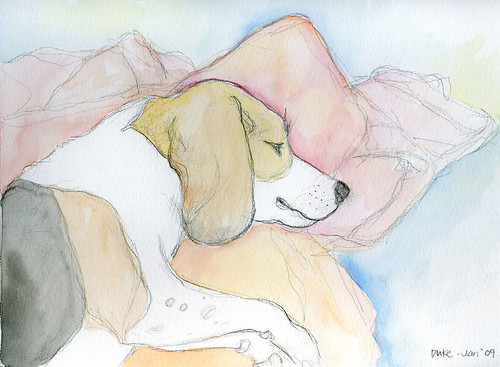
Since we initially started this blog to keep track of Duke's progress with his on-leash aggression and separation anxiety, this little post is a quick reminder for us to remember a couple of break through moments that happened this past week.
Ever since we moved, last summer, Duke regressed a bit with his separation anxiety and had to go back to being crated. Well, I'm happy to announce that after practicing planned departures everyday (some departures are as short as 5 min.) for several months, Duke has successfully stayed at home uncrated for 3.5 hours two days in a row!
Both times I found him curled up on our living room couch, sleeping as I walk through the front door. yay :) (Although I do see the sweaty paw prints on our floor of a stressed beagle pacing the house, the fact that he can settle down and nap is awesome beyond words)
Wednesday, January 14, 2009
Review of Feisty Fido by Patricia McConnell, Ph.D. and Karen London, Ph.D

Patricia McConnell needs no introduction. She's the author of the seminal book "The Other End of the Leash" (which I feel should be mandatory reading for every dog owner). I've read dozens of books on dog training and behavior and I've also noticed that the most helpful ones are written by people who have a scientific background and formal education (McConnell has a Ph.D in Zoology and her research focused on interactions between animals and their trainers).
Feisty Fido - Help for the Leash Aggressive Dog, is one of a series of short booklets McConnell's publishing company designed to address very specific behaviorial issues and offer advice in a very succinct and easy to digest manner.
This booklet is designed to help you if your dog is suffering from fear-based aggression while on leash. This book won't be that helpful for other forms of aggression (food/resource guarding, handler aggression, etc.)
What I like most about this booklet is the fact that its written in a way that makes me feel like McConnell and London are talking to me directly. My favorite example is when they describe different training situations in increasing difficulty:
Moderate:
On the sidewalk, as Muffy sees a dog she is friendly with 25 yards away
Difficult:
On the sidewalk, as Muffy sees a dog a third of a block away that she's charged at before
Really Hard:
On a walk when two off leash dogs run up to your dog and try sniffing her while their owner grins from a block away saying "It's Okay! My dogs LOVE other dogs!"
The other strength of this booklet is that it is the best description of a classical counter conditioning program I've ever read. Even a novice dog handler could read this book and do a decent job of implementing the prescribed program.
The only shortcoming of this book is its brevity and where this book ends. By following the program you'll have a dog that is counter conditioned to look at you and avoid pulling towards other dogs while on leash. A side benefit of this program is your dog will heel really nicely too. That's plenty for most and when we got Duke to this level, we were able to enjoy walks again and take Duke all over the place. But if you want to go beyond that and have your dog meet and greet dogs on leash consistently, you'll need to look at Feisty Fido as the first step in a much longer program.
(You can buy the book (and support BayingBeagle.com) from Amazon.ca on the sidebar to the right)
Labels:
aggression,
dog behavior,
dog behaviour,
dog training,
duke
Monday, January 5, 2009
On Leash Aggression with Beagles, Part 2
Just a quick post here. I found this great blog site by the owner of an Italian Greyhound named Peyton. He has made great progress with Peyton and has a video clip showing two very important techniques that we also use for Duke. If we end up getting cornered (dog on the left, right, front, and back) and there's no escape, this is what we do.
The two exercises being demonstrated are the Back Away and Emergency Hold.
Why are these exercises so important? It is very important to set your dog up for success and prevent him from acting inappropriately around other dogs. Each time he lashes out, you are making his problem worse by reinforcing the behavior. Its just like water - over time, water can etch into stone. Each time you put your dog in a situation where he reacts inappropriately, you've etched that behavior deeper into his psyche.
Peyton's blog can be found here for more reading:
http://igtraining.blogspot.com/2007/09/leash-aggression.html
The two exercises being demonstrated are the Back Away and Emergency Hold.
Why are these exercises so important? It is very important to set your dog up for success and prevent him from acting inappropriately around other dogs. Each time he lashes out, you are making his problem worse by reinforcing the behavior. Its just like water - over time, water can etch into stone. Each time you put your dog in a situation where he reacts inappropriately, you've etched that behavior deeper into his psyche.
Peyton's blog can be found here for more reading:
http://igtraining.blogspot.com/2007/09/leash-aggression.html
Labels:
aggression,
beagle,
dog behavior,
dog behaviour,
dog obedience,
obedience
Subscribe to:
Posts (Atom)
